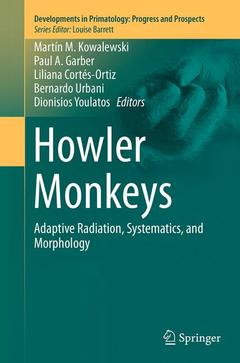Description
Howler Monkeys, 2015
Adaptive Radiation, Systematics, and Morphology
Developments in Primatology: Progress and Prospects Series
Coordinators: Kowalewski Martín M., Garber Paul A., Cortés-Ortiz Liliana, Urbani Bernardo, Youlatos Dionisios
Language: English
Subjects for Howler Monkeys:
Publication date: 09-2016
Support: Print on demand
Publication date: 12-2014
425 p. · 15.5x23.5 cm · Hardback
Description
/li>Contents
/li>Comment
/li>
Howler monkeys (genus Alouatta) comprise 12 species of leaf-eating New World monkeys that range from southern Mexico through northern Argentina. This genus is the most widespread of any New World primate and can be found to inhabit a range of forest types from undisturbed rainforest to severely anthropogenically-impacted forest fragments. Although there have been many studies on individual species of howler monkeys, this book is the first comprehensive volume that places information on howler behavior and biology within a theoretical framework of ecological and social adaptability. This is the first of two companion volumes devoted to the genus Alouatta.
This volume:
· Provides new and original empirical and theoretical research on howler monkeys
· Presents evolutionary and adaptive explanations for the ecological success of howler monkeys
· Examines howler behavior and ecology within a comparative framework
These goals are achieved in a collection of chapters written by a distinguished group of scientists on the evolutionary history, paleontology, taxonomy, genetics, morphology, physiology, and anatomy of howlers. The volume also contains chapters on howlers as vectors of infectious diseases, ethnoprimatology, and conservation.




